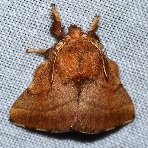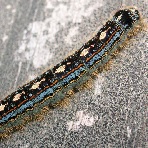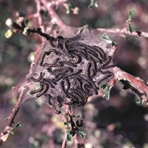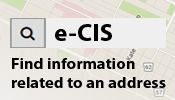Forest Tent Caterpillars
What are forest tent caterpillars?

Photo credit:
Andy Reago & Chrissy McClarren under license
CC BY 2.0
Forest tent caterpillars, a species native to North America, is the most spectacular of forest defoliators. These defoliators, although an infrequent pest in Winnipeg, can cause considerable damage when an outbreak erupts. Outbreaks occur about every 15 years and last about 3 years. While aspen is its preferred host, during severe infestations the forest tent caterpillar will feed on ash, fruit trees, maple, oak, birch, elm, deciduous shrubs and some garden plants.
What do forest tent caterpillars look like?

Photo credit:
Beatrice Murch under license CC BY 2.0
The adults are tan coloured, with two thin dark, parallel oblique lines or one single, broad, dark band crossing the middle of the front wings.
The mature larvae are 45-55 mm long and are bluish to brownish in colour with diamond-shaped white spots on the middle of the back of each segment. It has 2 thin, prominent broken yellow lines that extend along each side of its hairy body.
What is the life cycle of the forest tent caterpillar?

Adult moths emerge in early July and lay their eggs in a single gray-brown band 1.5-2.0 cm. deep that encircles a small twig of the host tree and shrub. Within 3 weeks a young larvae forms within the egg, but it remains dormant until the following spring. When the leaves begin to open, the larvae emerge and begin to feed. During the larval stage, they can be often found clustering in masses on the stem or trunk. The larvae feed over a 4-6 week period before becoming pupae. They form their cocoons between 2 leaves of a tree, on shrubbery or on buildings where they can find a sheltered location.
What does the damage look like?
Larvae feed initially on the opening buds, later consuming parts of or whole leaves of broad-leaved deciduous trees and shrubs. During high populations, forest tent caterpillars can completely strip trees and will then feed on the understory shrubs and other vegetation.
Will my tree die?
Healthy trees grow back their leaves 2-3 weeks after defoliations. However, after repeated defoliation, trees may be more susceptible to secondary insects and diseases.
How can I control forest tent caterpillars?
On smaller trees and shrubs, an effective means of controlling the forest tent caterpillar is pruning or breaking off the egg masses on the twigs and disposing of them in the garbage. This is best done in fall or in early spring when there are no leaves on the trees and the egg masses are most visible. After hatching, young colonies of larvae can be pruned off or squashed while they are resting in clusters on the main stem, especially in the evening or on cool nights.
When trees are too large or there are numerous larvae, a non-chemical insecticide, Bacillus thuringiensis var. kurstaki (Btk) or a chemical insecticide such as Insecticides such as Malathion® can be sprayed when the caterpillars are about 1-2 cm long. Biological products like Safer's BTK® Biological Larvicide contain the active ingredient Bacillus thuringiensis var. kurstaki (Btk) to control forest tent caterpillar larva. All Pest Control products purchased and used must be registered with Health Canada and contain a Pest Control Product (P.C.P. or PCP) Number on their label. Tanglefoot banding your trees will not be effective in controlling the forest tent caterpillar as the female moth is winged and can fly to the twigs and branches to lay her eggs.
Please ensure all contractors treating City-owned trees abide by the Agreement for Contractors to Perform Arboricultural Services on Trees Under The Control of The Urban Forestry Branch.


